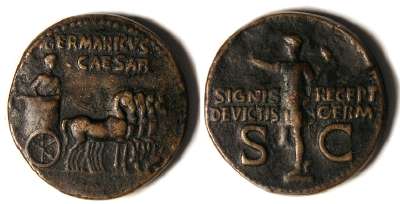
Fake Germanicus Dupondius
Enlargement This is a fairly good fake of a Germanicus depondius of a style of forgery that suggests a lost wax cast of the 19th century. MANUFACTURE: Lost-wax casting. SIZE: 28.5 X 29.4 mm. WEIGHT: 16.03 grams. FIRST IMPRESSION: Relatively good at first glance but not good enough to pass on any significant examination. RELATIVE DANGEREXPERIENCED DEALER - very low COLLECTOR WITH EXPERIENCE - relatively low COLLECTOR BUT NOVICE - relatively high CHARACTERISTICS: The first thing you notice is that in spite of grading VF with a nice strike, the details are much softer than one would expect. This is a common feature on many cast forgeries. An examination of the edge shows clear evidence of a casting seam, even though an attempt was made to hide this seam along much of the edge : 
There is also clear evidence of a pseudo flan crack at 2 o'clock on the reverse. While not obvious on the image, with the coin in hand it also clear on the obverse directly opposite that on the reverse. But there is no evidence of that crack extending around the edge, or into the coin, as there should be there if the crack was really caused by stress during striking : 

Traces of that crack were probably present on the edge when this example was first cast, but were removed when the edge was "worried" to disguise evidence of a casting seam. This is clear proof that this coin is not genuine.
After casting, this coin was "worried" to remove signs of the casting (although only partially successfully), and artificially toned to give it an appearance very similar to how many genuine coins cleaned with 19th century methods look. While a careful examination of this coin shows many features that would individually condemn it as a fake, coins like this still often show up being offered as genuine, and fool many novice collectors and dealers. Back to examples of fakes. Top of Page
|


